I’m not one to throw money at kitchen gadgets lightly, but the Kuvings AUTO10 has me convinced it’s worth every penny. This hands-free, cold-press juicer is a game-changer for anyone who loves fresh juice but hates the prep and cleanup.
With its massive hopper and quiet motor, it’s built for convenience and quality. Whether you’re juicing for health, flavor, or just to impress your friends with vibrant concoctions, this machine delivers.
Trust me, you’ll want this sleek beast on your counter—it’s a purchase you won’t regret.
My First Month With The Kuvings AUTO10
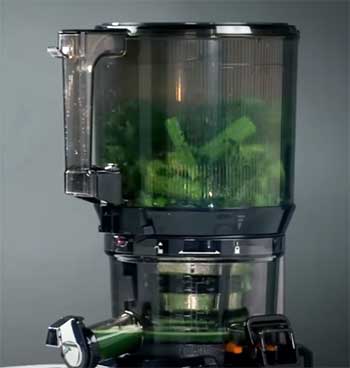
When I unboxed the Kuvings AUTO10, I was immediately struck by its sleek design—available in pearl black, white, silver, or red, it’s a looker that screams “I mean business.”
My kitchen counter isn’t exactly spacious, so I was a bit skeptical about its size, but the promise of hands-free juicing had me hooked.
I decided to put it through its paces, juicing everything from leafy greens to whole beets, and even experimenting with smoothies and sorbets.
My first test was a classic green juice: kale, celery, cucumber, spinach, and a lemon for zing.
I tossed everything into the 100-ounce hopper—whole, no chopping needed—and flipped the switch.
The machine hummed to life, quieter than my old centrifugal juicer, which sounded like a lawnmower. At just 61 decibels, I could carry on a conversation while it worked. The juice flowed out smooth and vibrant, with pulp so dry I was impressed by the yield. I made enough for three days in one go, which is perfect for my batch-juicing routine.
Next, I tried ginger shots, mixing ginger with apple, honey, and a pinch of cayenne. The result was a fiery, fresh elixir that put store-bought shots to shame. I made 30 shots in one session, saving me a fortune.
The sorbet function was a fun surprise. I tossed in frozen mango and banana, and out came a creamy, plant-based dessert that had my kids begging for more. Cleanup, which I dreaded, was surprisingly quick—about five minutes with the included cleaning tools.
The only hiccup was some celery fibers getting stuck in the pulp chute when I didn’t pre-cut the stalks, but a quick rinse sorted it out. After a month, I’m hooked. This juicer has made healthy habits feel effortless, and I’m already planning my next batch.
Pros of The Kuvings AUTO10
- Hands-Free Convenience
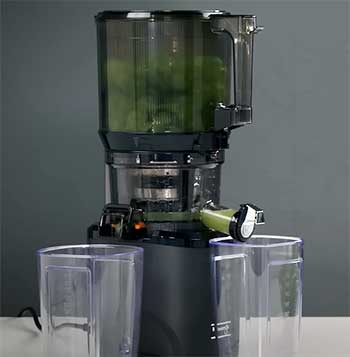
The AUTO10’s standout feature is its hands-free operation.
You load up the 100-ounce hopper—30% larger than competitors like the Nama J2—and walk away.
It’s a dream for multitaskers like me.
While it juiced, I prepped dinner or cleaned the kitchen, saving me at least 20 minutes per session compared to my old juicer, where I had to stand there feeding produce like a babysitter.
The auto-cutting blade handles whole apples, beets, and even tough ginger with ease, so you’re not stuck chopping everything into tiny bits.
- Impressive Juice Yield
The cold-press technology is a big win. Operating at 50 RPM, it gently squeezes every drop from your produce, preserving nutrients and flavor. I noticed the pulp was consistently dry, whether I was juicing carrots or leafy greens.
Compared to my old centrifugal juicer, which left wet pulp and less juice, the AUTO10’s yield was noticeably higher. I got about 350 ml of celery juice from one bunch, which is competitive with pricier models.
This efficiency means you’re getting more bang for your buck with every fruit and veggie.
- Quiet Operation
If you’ve ever winced at the roar of a juicer, you’ll love how quiet this one is. At 61 decibels, it’s like a low hum—perfect for early mornings when you don’t want to wake the house. I juiced at 6 a.m. while my family slept, and no one stirred.
Even when tackling tough ingredients like whole beets, it stayed smooth and quiet, unlike my old machine that groaned under pressure. This makes it ideal for daily use without disturbing your household or neighbors.
- Versatility Beyond Juicing
The AUTO10 isn’t just a one-trick pony. It comes with three strainers: juice, smoothie, and sorbet. I’ve made almond milk that was silkier than store-bought, and the sorbet attachment turned frozen berries into a dessert my kids devoured.
The smoothie strainer lets you keep more pulp for a thicker texture, which is great if you prefer heartier drinks. This versatility means you’re not just buying a juicer—you’re getting a multi-tool for your kitchen.
- Long-Lasting Durability
With a 240-watt motor and a 15-year warranty, this juicer feels like a tank. I’ve run it for 45-minute sessions without overheating, which is a huge upgrade from my old juicer that shut off after 40 minutes.
The materials—ULTEM, Tritan, and stainless steel—feel premium and built to last. Knowing I’ve got a decade and a half of coverage gives me peace of mind that this isn’t some flimsy gadget that’ll break in a year.
Cons of The Kuvings AUTO10
- Bulky Size and Storage Challenges
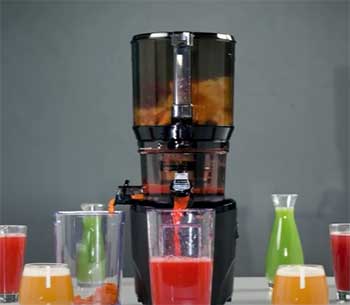
The AUTO10 is a beast, and not just in performance. At 10 x 8 x 18 inches and 16.5 pounds, it’s a space hog.
My kitchen counter is already crowded, and this juicer doesn’t fit under standard cabinets when fully assembled.
Storing it in a cupboard is a workout—hauling it out for weekly juicing sessions is a hassle.
If you’ve got a small kitchen or limited storage, you’ll need to plan where this giant lives.
I’ve made peace with it, but it’s a real consideration for cramped spaces.
- Celery Clogging Issues
While the AUTO10 handles most produce like a champ, celery gave me some trouble. Long stalks (around 6 inches) caused fibers to clog the pulp chute after one bunch.
I learned to chop celery into 2-3 cm pieces, which solved the problem, but it’s an extra step I wasn’t expecting for a “hands-free” machine. This isn’t a dealbreaker, but if celery juice is your daily go-to, be prepared to do a bit of prep to avoid clogs.
- Higher Price Point
At $699, the AUTO10 isn’t cheap. Compared to the Nama J2, which costs $550, it’s a significant investment. The larger hopper and included sorbet attachment justify some of the cost, but if you’re on a budget or don’t need the extra capacity, you might hesitate.
I wrestled with the price tag myself, but the time savings and quality output made it worth it for me. Still, it’s something to weigh if you’re not a frequent juicer.
- Occasional Produce Waste
Sometimes, a bit of produce gets stuck in the hopper’s base after a juicing cycle. It’s not a huge amount—maybe a few chunks of apple or carrot—but you’ll need to open the lid and scrape it down to juice everything.
It’s a minor annoyance, especially with the large hopper, but it feels like a small inefficiency in an otherwise stellar machine. A quick scrape fixes it, but perfectionists might find it irksome.
Maintenance Tips For The Kuvings AUTO10
- Clean Immediately After Use
Trust me, don’t let juice residue dry on this machine. Cleaning right after juicing is a breeze and takes about five minutes. Close the juice outlet flap, pour in half a liter of water, and run the motor for a few seconds.
Then, open the flap to drain the water, disassemble the parts, and rinse them under running water. The included cleaning brush makes quick work of the juicing screen, and the special strainer tool is a lifesaver for getting pulp out of tight spots.
This habit keeps your juicer spotless and prevents sticky buildup.
- Use the Reverse Gear for Blockages
If you notice a jam—say, from overloading the hopper with fibrous greens—don’t panic. The AUTO10 has a reverse gear that’s a godsend. Flip the switch to “REV” for a few seconds to dislodge the blockage, then switch back to “FWD” to resume juicing.
I had to do this once when I got overzealous with whole carrots. It’s simple and prevents you from dismantling the machine mid-session. Just don’t overuse the reverse gear, as it’s meant for quick fixes, not constant toggling.
- Pre-Cut Fibrous Produce
To avoid clogs, especially with celery or kale, chop fibrous produce into 2-3 cm pieces before loading the hopper. I learned this the hard way after celery fibers gummed up the pulp chute. It doesn’t take long—just a quick chop—and it ensures smooth juicing.
For apples or pears, quarter them to maximize hopper space and speed up the process. This small prep step makes a big difference in performance and reduces the chance of stuck produce.
- Store Parts Properly
The AUTO10 has several parts—hopper, lid, juicing bowl, auger, strainers—so storage can get chaotic. I keep mine in a dedicated kitchen drawer, with the strainers in a separate container to avoid scratches.
The detachable power cord is a nice touch for tidy storage, but make sure you don’t misplace the smaller cleaning tools. I almost lost the strainer tool once, and it’s essential for thorough cleaning.
A little organization goes a long way to keep everything in top shape.
- Check the Smart Cap Regularly
The removable smart cap on the juice spout is a cleaning win, but it can wear out if you’re not careful. Inspect it weekly for cracks or loose seals, especially if you’re juicing daily. I rinse mine separately to ensure no pulp gets trapped, which could lead to leaks over time.
If you notice any damage, contact Kuvings for a replacement under the 15-year warranty. Keeping the cap in good condition ensures your juicing bowl stays leak-proof during those long batch sessions.
Comparison With Other Juicer Brands
- Nama J2
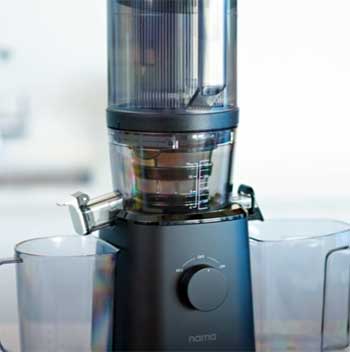
The Nama J2 is the AUTO10’s closest rival, and I spent weeks debating between them before pulling the trigger.
Priced at $550, the J2 is more budget-friendly, and its 65-ounce hopper is still generous for most home juicers.
It’s also more compact, standing at 17 inches tall, so it fits under standard kitchen cabinets—a big plus if your counter space is tight.
The J2 excels with leafy greens, often squeezing out slightly more juice than the AUTO10 in tests I’ve seen online.
However, its 30-minute runtime can be limiting for batch juicing compared to the AUTO10’s 45 minutes. The J2’s optional larger hopper and sorbet attachment cost extra, whereas the AUTO10 includes the sorbet strainer standard.
If you prioritize affordability and don’t need massive batches, the J2 is a strong contender, but the AUTO10’s larger hopper and longer runtime tipped the scales for me.
- Hurom H70
The Hurom H70 is another solid option, and a friend of mine swears by hers. It’s a vertical slow juicer like the AUTO10, with a focus on nutrient preservation through its 50 RPM motor.
It’s quieter than some competitors and produces high-quality juice, but it lacks the hands-free hopper that makes the AUTO10 so convenient. You’ll need to feed produce manually, which can feel tedious if you’re juicing for a family.
The H70 is also bulky, similar to the AUTO10, but its design is less modern, and it doesn’t come with the same range of strainers. If you don’t mind hands-on juicing and want a reliable machine, the H70 is great, but it can’t match the AUTO10’s time-saving automation.
- Angel Juicer
For those chasing the absolute highest juice yield, the Angel Juicer is often touted as the gold standard. Its twin-gear system extracts every last drop, especially from tough ingredients like celery or microgreens.
However, it’s a beast in both price (often over $1,000) and effort.
There’s no hands-free feature, so you’re stuck feeding produce bit by bit, and cleanup is a chore compared to the AUTO10’s streamlined process. I considered the Angel for its yield but couldn’t justify the price or time commitment for my needs.
If you’re a hardcore juicer with deep pockets, the Angel might appeal, but the AUTO10 offers a better balance of convenience and performance for most.
- Kuvings REVO830
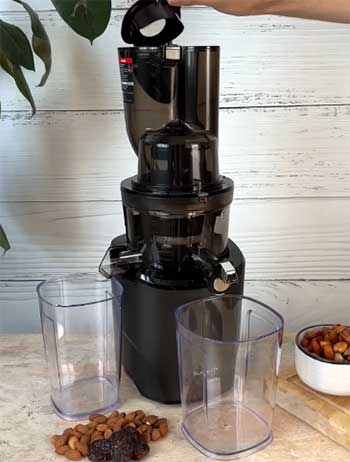
Kuvings’ own REVO830 is a worthy sibling to the AUTO10, but it’s a different beast.
Unlike the AUTO10’s hands-free hopper, the REVO830 requires manual feeding through a wide chute that can handle whole apples.
It’s great if you prefer more control over what goes into the juicer and when, but it lacks the set-it-and-forget-it ease of the AUTO10.
The REVO830 is slightly cheaper, around $649, and has the same 240-watt motor and 15-year warranty.
Its juice yield is comparable, but it’s less suited for large batches. I chose the AUTO10 for its automation, but the REVO830 is a solid pick if you don’t need the hopper.
Frequently Asked Questions (FAQ)
Absolutely, if you’re serious about juicing. The AUTO10’s hands-free design, high yield, and versatility make it a fantastic investment for frequent juicers. The $699 price tag is steep, but the time savings, quiet operation, and 15-year warranty justify it for me. If you only juice occasionally, a cheaper model might suffice, but for batch juicing and consistent use, this machine shines. The dry pulp and nutrient-rich juice mean you’re getting the most out of your produce, which saves money in the long run.
The AUTO10 Plus, released in November 2024, is an upgraded version of the AUTO10. The main difference is the hopper size: the AUTO10 has a 100-ounce hopper, while the Plus boasts a massive 135 ounces, perfect for larger batches. The Plus also swaps the AUTO10’s plastic cutting blade for a stainless steel one, which handles tough produce like beets and ginger more efficiently. The Plus has a 60-minute runtime versus the AUTO10’s 45 minutes, and it’s priced at $739 compared to $699. If you juice for multiple people weekly, the Plus is worth the extra cost.
No, Kuvings is a South Korean company, founded over 40 years ago. They’re known for their high-quality slow juicers, especially wide-mouth models like the AUTO10. Their manufacturing and design focus on durability and innovation, with a strong reputation in markets like Germany and the U.S. I’ve seen some confusion online, but rest assured, Kuvings is proudly South Korean, and their 15-year warranty reflects their confidence in their craftsmanship.
The AUTO10’s parts aren’t dishwasher safe, which is common for high-end juicers to protect their materials like ULTEM and Tritan. I clean mine by hand, and it’s honestly quick—five minutes with the included brushes and tools. Running water through the juicing bowl right after use prevents residue from sticking, and the strainer tool makes scrubbing a breeze. While a dishwasher option would be nice, the easy hand-cleaning process hasn’t been a hassle for me.
Why The Kuvings AUTO10 Is A Must-Have?
After a month of juicing with the Kuvings AUTO10, I’m sold. Its hands-free convenience, high yield, and quiet operation make it a standout in my kitchen. From vibrant green juices to creamy sorbets, it handles everything with ease, saving me time and effort.
Despite its size and price, the quality and versatility are unmatched. If you’re ready to elevate your juicing game, this is the machine to get. It’s an investment in health and convenience you’ll thank yourself for every time you sip a fresh, nutrient-packed juice.
